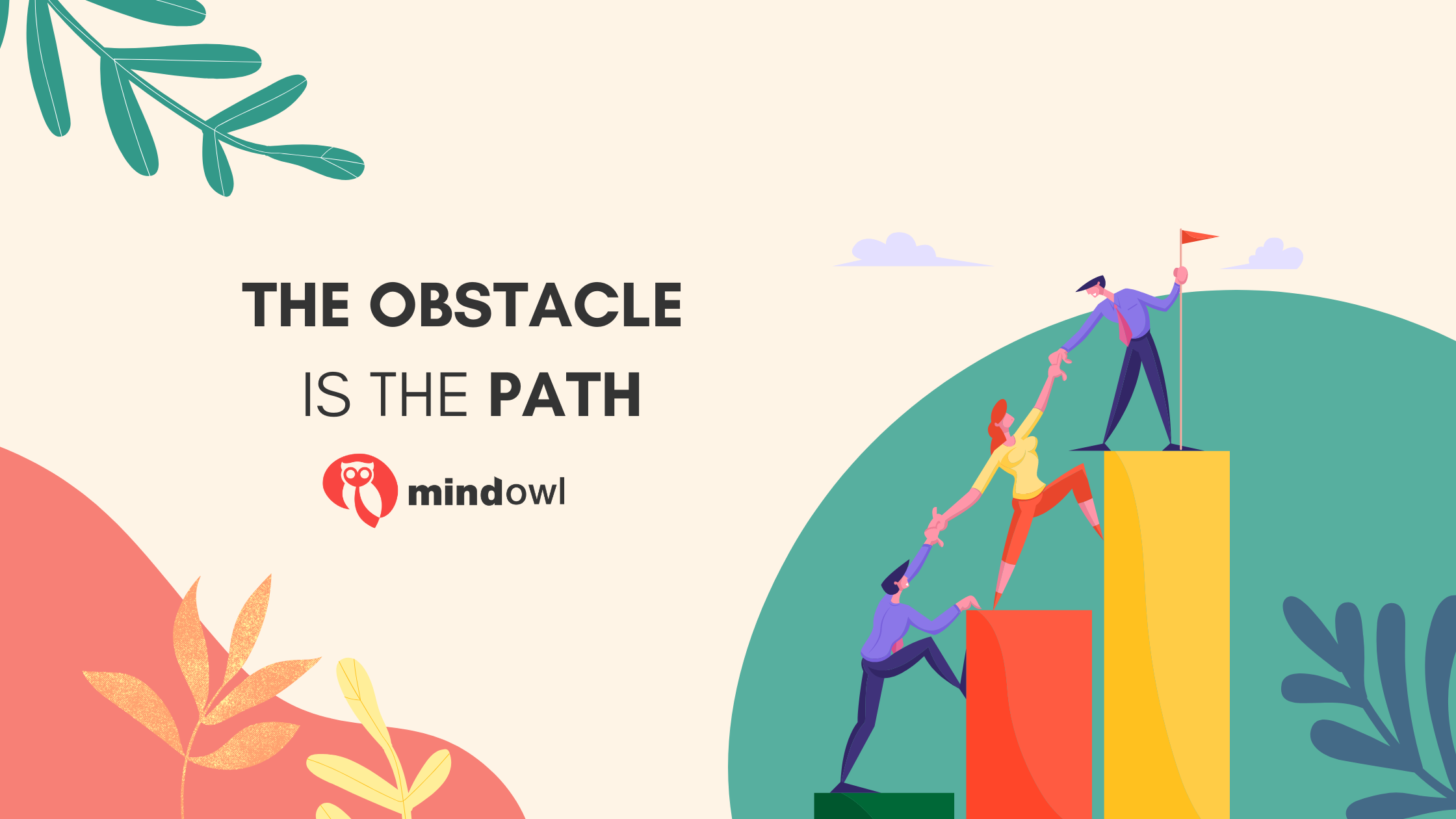Deriving from a Zen proverb, the phrase ‘the obstacle is the path’ refers to the idea that no obstacle can be navigated just by avoidance; you must tackle it head-on.
This school of thought insists that obstacles actually present opportunities for improvement. Overcoming challenging situations can make us stronger, more resolute, and more robust. Choosing the ‘easy’ way out stops us from embracing and confronting challenges.
The Zen mindset is all about taking control of the choices in our lives, and one of the most crucial choices we can make is to face these obstacles rather than sidestepping them. As writer and creative Darnell Lamont Walker says, “Sometimes our walls exist just to see who has the strength to knock them down”. By being flexible, courageous, and resilient, we can transform obstacles into the most crucial part of the journey.

Choosing the ‘easy’ way out stops us from embracing and confronting challenges.
Would you rather have a good life or an easy one?
Life is not supposed to be easy. Trying, failing, and learning from our mistakes is a key part of the journey of life. These tests of character help us become better, healthier, and more robust; if you have an overly comfortable life, you won’t grow as an individual. The successes of athletes or great artists are prime examples of obstacles being transformed into paths.
Failure can also cause us to pursue an alternative path that we may not have considered, which may open up a more effective way of achieving a goal. Confronting challenges can also allow us to realise that our true obstacles are not external but inside us. Other unexpected benefits can also arise from this process. For instance, experiencing and surviving a heavy loss or a terrible illness can make us uniquely equipped to offer support, hope, and guidance to others experiencing something similar.
When coming across obstacles, it’s typical to want to shift back into your comfort zone. Most of us never leave these comfort zones, meaning that we don’t give ourselves the opportunity to overcome barriers, and risk becoming complacent. While it is important that we believe in our own ability to deal with challenges, complacency is a dangerous attribute; it’s important to strike a balance.
Learn to Accept Failure and Adversity as Part of Life
Buddhists believe in the power of changing poison into medicine. That refers to the idea that all people are endowed with an innate capacity for finding a silver lining, and creating value out of any situation, no matter how bad it may seem. Ryan Holiday, author of The Obstacle is the Way, argues that “Blessings and burdens are not mutually exclusive”. Acknowledging that a situation is challenging means acknowledging that you have room to grow, which can make this admission difficult. However, it is crucial that we try to embrace our struggles, flaws, and bad experiences, in order to overcome them.
Acknowledge adversity for what it is
In ancient times, the stoic philosophy of amor fati, meaning ‘love of one’s fate’, proposed that we embrace our lives exactly as they are, treating adverse circumstances and discomfort in life as necessary for developing strength, knowledge, and resilience.
Difficulties in life are inevitable. These may include challenges with relationships, stressful or overwhelming circumstances at work, feelings of grief, fear, or anxiety, or criticism from those around you. Essentially, we have two choices when dealing with such obstacles: denial, or confrontation. Denial involves pretending these challenges aren’t there, or running from them. Confrontation represents a better alternative, because it allows us to develop our ability to deal with challenges. The Zen approach to life uses practices like meditation to help us make conscious choices to confront our issues.
Here’s a practical step to help you counter difficult experiences in life.
Each time challenges arise, use ‘the obstacle is the way’ as an antidote to anger, and tell yourself to see this as an opportunity. The more you do this, the better you will get at interpreting obstacles as opportunities, a process which can lead to a more complete life. Stoicism is founded on the belief that there is no good or bad, only perception. You can’t control what happens to you, only how you respond to it, so you may as well choose to respond well.
Who is Marcus Aurelius and what did he do?
Ancient Stoics firmly believed that rather than preventing us from doing something, an obstacle in fact presents an opportunity to overcome something. One of the most prominent members of this school of philosophy was Marcus Aurelius, the Roman emperor who once wrote “The impediment to action advances action. What stands in the way becomes the way”.
Marcus Aurelias proposed that only by facing a strong enemy can we become strong ourselves, and this increased strength can give us a greater sense of confidence and calm when navigating life’s challenges. Meditations, his series of personal writings, asks us to choose how we react to people who are rude, aggressive, or difficult. Do we view them as enemies or allies, obstacles or opportunities? ‘The obstacle is the path’ philosophy suggests that we accept these challenges as inevitable, and approach them head on.
What is living above the line?
Living above the line means taking ownership of your life, being accountable for it, and acting responsibly. On the other hand, living below the line means handing over control of your circumstances to other people and external situations. For example, living below the line would involve making excuses, blaming other people for your problems, and living in denial or with a sense of entitlement. The ‘line’ separates empowerment from disempowerment, and the paradigm of Victor/Results vs. Victim/Reasons.
How can you identify whether you are living above the line or below it? Ask yourself these questions:
- Are you ready to take ownership of a given task or project entirely?
- Are you ready to do your best and make yourself accountable for the quality of work you produce?
- Are you going to hold yourself responsible for the end product?
A difficult aspect of living above the line is acknowledging and accepting when things don’t go as you’d planned or hoped. However, these moments provide natural opportunities for growth. This principle is what underpins the idea of seeing the obstacle as the path.
How can I use ‘the obstacle is the path’ in my life?
There are a number of situations in which you can benefit from believing that the obstacle is the path. Here are a few particularly useful ones.
Combat procrastination
We all experience procrastination, whether it be while writing, reading, checking emails, or performing work tasks. While procrastination is the symptom, it also illuminates the path you should take, by revealing that you are anxious about a particular aspect of the writing, or you’re shying away from discomfort, or you’re fearful about what will happen after you complete a task. Try and understand these dreads, discomforts, and fears; wrap your head round them, and you’ll be better equipped to deal with them.
Tackle shyness and difficulty meeting people
If your shyness stops you from meeting people or doing things, you may view it as a major obstacle to social happiness. Therefore, it is perfectly normal to just avoid confronting it, instead choosing to stay in and not socialise. However, by instead choosing to dive into this shyness, explore it, find out exactly what you’re afraid of and try to work with that fear, you can become much better at handling it.
Reduce feelings of stress at work
Feeling stressed or overwhelmed at work is a common problem. You could simply complain about this forever, or you could immerse yourself in the problems you have at work, perform some serious self-exploration and get to the source of that stress. By doing this, you can uncover the unrealistic expectations and ideals you might have, and learn how to let go of them.
Deal with criticism and conflict better
Facing criticism from others may make you angry, or resentful towards the world, or it may cause you to just avoid certain people. If instead, you attempt to embrace their concern, engage them in conversation and explanation, and be thankful that they care about you, you may not only reduce these negative feelings, but you may also help them to understand your perspective better. There are parallels between this practice and Loving-Kindness meditation, which focuses on actively cultivating feelings of kindness and compassion towards ourselves and others.
All these situations are linked by a crucial principle: when there’s an obstacle, don’t go around it, don’t run from it, go into it. Explore your obstacles, learn how to deal with them, and you will develop skills for life.
How meditation can help you deal with adversity
Mindfulness meditation breeds resilience. It weakens the chain of associations that keep people obsessing about their problems or failures, meaning they are more likely to show resilience and try again. Due to the neuroplasticity of our brains, our ability to focus, pay attention, and calm down (the most important responses to facing obstacles) all benefit from meditation. The Zen Buddhist approach to life focuses on how meditation can also help you access your subconscious mind, which is a source of great wisdom and insight.
Some of the key techniques needed to view the obstacle as the path have strong links with meditation. For instance, asking yourself questions about how you want to approach obstacles in life contains evident parallels with the self-examination of direct enquiry meditation. The ambition of unlocking the potential of our unconscious minds is also fundamental to meditation. Similarly, gaining greater insight into our motivations, values, and why we think the way we do is essential to both practices. Therefore, it can be useful to refer to Stoic Meditation techniques when learning to implement a ‘the obstacle is the way’ mentality.
3 Stoic Meditation Exercises to try today
Contemplation of the Whole – Imagine viewing the entire world from high above, as if you’re one of the gods looking down from Mount Olympus. Think about the whole of space and time, and contemplate your place within it. If we take a moment to think about the transience of material things, and the small space a human life takes up in the vastness of the whole world, it can help make our problems seem a little less daunting.
Life is long – if you know how to use it – Next time you find yourself saying “I don’t have time” to do something, ask yourself – is this actually true? Or are you just committed to lots of unnecessary things? We’re all guaranteed to waste much of our limited time on earth, but by questioning our own choices and activities, we can reduce this waste and make sure we are using our time well.
Treat your time like you treat your money – This is linked to the previous Stoic meditation. Generally, we are far more liberal about how we spend our time than how we spend our money. We let people and obligations impose themselves on our days, without asking ‘What am I getting in return?’ If we begin to pose these questions, it can revolutionise how we spend our time.
Conclusion: It’s All a Part of the Journey
If your current path seems blocked by an obstacle, tell yourself that it is not a fixed path and that the road ahead of you can be altered. By confronting obstacles and devising logical ways to deal with them, you can turn these moments into crucial events which lead to more joyful experiences. Each time you encounter an obstacle, consider what actions you can take to transform it into an opportunity. Try to supplement these efforts with some of the Stoic Meditations explained above, and remember how Zen Buddhism uses meditation to help us make more conscious choices. By following these practical steps, you can strengthen your ability to treat the obstacle as the path, and in doing so, open yourself up to some inspiring and joyful moments of personal growth.
MindOwl Founder – My own struggles in life have led me to this path of understanding the human condition. I graduated with a bachelor’s degree in philosophy before completing a master’s degree in psychology at Regent’s University London. I then completed a postgraduate diploma in philosophical counselling before being trained in ACT (Acceptance and commitment therapy).
I’ve spent the last eight years studying the encounter of meditative practices with modern psychology.




One thought on “The Obstacle is the Path: a Zen approach to overcoming any challenge”